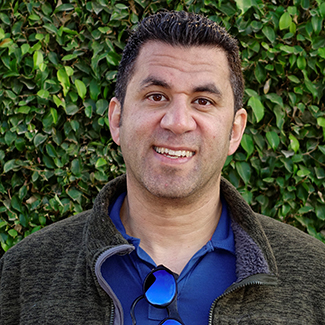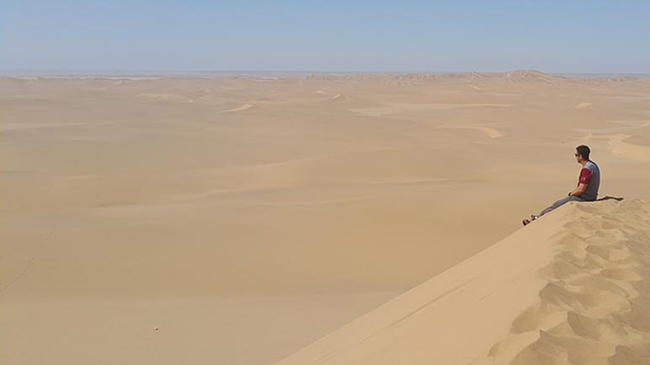
Associate Professor of Biology
School of Natural Sciences
By Steven Krolak
(NEW ALBANY, Ind.)–Dune 45 in Swakopumund, Namibia is a towering lump of sand. The small group of IU Southeast students and instructors have been hiking for nearly an hour in near darkness to scale the summit before dawn, and experience the magic of a desert sunrise. It comes on slowly but irrevocably, seemingly bathing the world in copper. There are some whoops, then silence as the profound size and scope of the desert engulfs all thought.
And then it’s the moment most have been waiting for: the downhill.
One by one, they take off, trying to jog or ski or glide, before gravity takes over and all hell breaks loose. They slip, slide, tumble, laughing and/or screaming, in gravity’s thrall.
Welcome to the classroom of Dr. Omar Attum, associate professor of biology.
Research as empowerment
Attum has made a name for himself in both academic and popular circles as an expert in the desert ecology of the Middle East.
He has published countless scholarly articles and also the book, Sinai, with gorgeous photographs of life in one of the most arid environments on Earth.
His exposure and expertise benefit IU Southeast students in profound ways.
The most obvious is in the campus classroom.
Attum’s courses come alive with his first-hand familiarity with faraway arid ecosystems both obscure and illuminating.
Obscure because they are profoundly alien to students from a relatively lush environment like the Ohio Valley, and because they are really off the beaten track: Jordan, South Africa, Namibia, the Red Sea.
Illuminating because the principles and processes underlying the biological sciences are more readily apparent in the desert than in other ecosystems.
“In the desert, every animal you see is a story of evolution and natural selection, because in order to survive, they have to had to adapt to this specific environment,” Attum said.
Case in point: the burrowing skink, a lizard without legs that moves beneath the surface of the sand. Or the shovel snouted lizard, whose feet have fringes like snowshoes to keep it from sinking into the dunes.
Then there is the other classroom: the desert itself.

For the past 10 years, Attum has led field biology trips to desert destinations.
On these trips, students rough it. They live as close to the local lifesteyle as they can, and are encouraged to pick up on the culture as well as the ecology.
Attum doesn’t just lead students, he challenges them—in his quiet way–to become self-sufficient scientists.
Many instructors take students out into the field to gain experience by performing a set of pre-ordained activities. Attum’s approach is different. He gives students the opportunity to become experts in specialized areas, and to share their knowledge with the rest of the class in the field.
Recently, one student wanted to learn more about fish in the Red Sea, and another was interested in birds of Jordan. Attum supported their initiative. While they were in New Albany, learning everything they could about species identification, Attum was in the Middle East, setting up GoPros and camera traps. He returned with footage and photos for them to analyze.
“I’m familiar with these birds and fish, and can usually identify them, but I’m not an expert,” Attum said. “The students spent hundreds of hours looking at these species, and when we were finally on site, the other students and I learned species identification from them.”
This is how science works. Nobody knows everything. The body of knowledge is an accretion of granular observations, a mosaic of shared expertise. An individual project might sound almost comically arcane, but every finding has its part to play in the grander scheme, helping to build a more informed picture of life’s complexity.
Accepting that reality about scientific inquiry takes patience, humility and the ability to appreciate the implications of a study without demanding Earth-shattering breakthroughs at every turn.
It’s sobering, but it’s how Attum’s students gain confidence.
“When you’re out in the field for a week, you can’t hide,” Attum said. “You either know your stuff or you don’t.”
In Attum’s view, travel into the field, especially to remote locales, inherently prepares students to problem-solve. By giving them the latitude to rely on their own knowledge and judgment, he demonstrates his trust in their ability. So far, they have always risen to the challenge.
Awe of the desert
There is no inherent or logical connection between IU Southeast and the deserts of Jordan or Namibia. To understand how these trips came to be, you have to understand Attum’s personal history, which forms the backbone of his method, both as a researcher and instructor.
Born in New York, Attum grew up in Baltimore, Maryland, far from the wilderness. But his father, a doctor who worked long hours, used his precious free time taking spontaneous trips to wild places and hammering home the importance of education.
These were important lessons, but by far the most formative influence was that of his mother, who was Egyptian and maintained close contact with her family in her native land. As a result, Attum grew up spending holidays in Egypt. While there, the family often recreated at popular archeological sites such as the Valley of the Kings. Like kids everywhere, Attum was allowed to roam freely, provided he returned in time for dinner.
Attum spent hours in a magical landscape harboring birds, bats, insects, foxes, snakes, lizards, and more amid the ruins of temples and monuments. There were surprises around every corner, nooks and crannies that harbored signs, symbols, tracks, mysteries, clues.
“I remember always having this awe of the desert,” Attum said. “As kids, you could always imagine discovering treasure or a mummy.”
It was in those years that Attum became accustomed to being without creature comforts like air conditioning, electricity, medicine, fresh water on demand, and entertainment.
“Going overseas meant exploration, freedom, remoteness and not being afraid to be uncomfortable,” Attum said.
By the time he had decided on a career, he knew not only what he wanted to do—poke around in nature–but how he wanted to do it: by poking around in nature.
This focus sharpened in college. While most students blew their savings on Spring Break in Florida, he went to Egypt, where he could live on pennies a day while exploring the Red Sea or other remote haunts. In graduate school, he spent more time in the desert conducting research, and got to know fellow scholars and the academic worlds they inhabited. The most meaningful encounters were informal collaborations in the field, not just with other biologists, but with scholars of all disciplines.

“Archeologists, linguists, political scientists, anthropologists—I was exposed to intellectuals who were very passionate about their work,” Attum said.
These serendipitous encounters could be valuable. His knowledge of ecosystems and wildlife meant that photographers often sought him out as someone who could guide them to fauna like vultures, venomous snakes or crocodiles. In the process, he saw how they worked to produce images that were not only interesting, but informative. And so he began to earn a bit of pocket money by contributing articles to publications such as Wildlife Conservation, as well as Egyptian newspapers and even photographic journals, reviewing camera equipment for viability in the desert. In time, he would become an expert not only with the camera, but in using the camera to supplement the science.
“As a biologist, it gave me an artistic way to articulate the environment,” Attum said.
That artistry is important.
“For an ecologist, everything is numbers, because that’s what goes into a statistical analysis,” Attum said. “A photographer tells the same story, but qualititatively.”
The ecologist views the desert as a matrix of percentages of vegetative cover. The photographer sees is as a landscape of history, politics, people.
It’s an interdisciplinary approach that Attum learned by doing, and one he hammers home in his classes.
“When I take students abroad, it’s a biology class, but they have to learn about the history of their destination, the culture, the religion in addition to species identification,” Attum said. “When they come out of it, this is what they appreciate.”
This is why Attum has invited guest lecturers to inform his students on issues ranging from medieval Islam to contemporary refugees.
It’s good pedagogy, and it’s also practical wisdom for aspiring field biologists, because local knowledge is the key to success.
“If you want to work in the Middle East, you have to be familiar with culture and history and geopolitics, because the area has been inhabited for so long by people, that there really isn’t any untouched place,” Attum said. “Even in protected areas we have to work with local communities because they have certain rights there, and you need to get their permission to do your research.”
Spitting in the sand
Attum’s innovation is to encourage, in a very systematic and intentional way, the eclectic academic and personal formation that he experienced.
Which brings us back to Dune 45.
The students learned to locate animals based on their tracks. They also caught shovel snouted lizards by spitting—fooling the lizards that catch windblown insects by intercepting their shadows on the sand. Cue delight.
“It is like watching the excitement of a child when they are proud for reading their first words,” Attum said. “It felt great to share with them all the little secrets I learned from the desert.”


